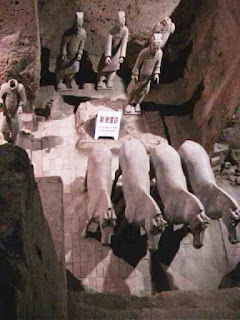Our day started with an early morning visit to the Great Mosque of Xi'an. This proved to be a rather ramshackle affair with decaying stone buildings and dishevelled gardens. The complex opened in 742AD during the Tang dynasty. However, most of the structures visible today date from a restoration completed in 1384 AD.
We then went for a walk along Xi’an city wall. This is an extraordinary structure. The old city is completely surrounded by a 14 kilometre long series of imposing stone walls. These massive fortifications are 12 metres high and 15 metres wide. They trace a 36 square kilometre rectangle around the old city, separating it from the modern central business district outside.
The walls were built more than 637 years ago during the Ming Dynasty. When completed they were surrounded by a moat and featured intricate drawbridges, arched gateways and a series of guard towers. While the moat has long gone, the walls, gates and towers remain today.
The largest pit, known as Pit 1, extends more than 230 metres and is 62 metres wide. It contains the main army consisting of more than 6,000 life-size figures. When it was originally constructed, it featured 11 corridors, about 3 metres wide, that were paved with bricks and enclosed by a wooden ceiling supported by large beams and posts. According to Wikipedia, this design was also used for the tombs of nobles and would have resembled palace hallways when built.
The entire site was then covered by more than two metres of overburden and thus remained hidden for two thousand years. Over the centuries the internal structure collapsed as the timbers decayed. However, since its discovery some of these filled corridors have been excavated and their rows of terracotta statues painstakingly restored from shattered fragments.
The other pits on display proved equally memorable. I particularly liked Pit 2. It has cavalry and infantry units as well as war chariots. It’s thought to represent a military guard. Pit 3 is the command post, with high-ranking officers and a war chariot. We later learnt that Pit 4 is empty for reasons still unknown to scholars.
We kicked off our brief wall walk from the South Gate, the oldest and grandest of the wall’s four main gates. Then, with the help of the hotel concierge, we made our way by private taxi to the Terracotta Army Museum, approximately 40 kms from the old city.
The Terracotta Army was discovered on 29 March 1974 by a group of farmers digging a well approximately 1.5 km east of Emperor Qin Shi Huang’s tomb mound. The mound itself has never been opened. However, its terracotta companions have been extensively excavated, a work in progress that continues unabated today.
Four main pits approximately 7 metres deep have been excavated. Each is enclosed by an enclosed steel atrium that protects it from the weather. It appears that the soldiers within were laid out as if to protect the tomb from the east, the direction in which the emperor’s conquered states reside.
The Terracotta Army was discovered on 29 March 1974 by a group of farmers digging a well approximately 1.5 km east of Emperor Qin Shi Huang’s tomb mound. The mound itself has never been opened. However, its terracotta companions have been extensively excavated, a work in progress that continues unabated today.
Four main pits approximately 7 metres deep have been excavated. Each is enclosed by an enclosed steel atrium that protects it from the weather. It appears that the soldiers within were laid out as if to protect the tomb from the east, the direction in which the emperor’s conquered states reside.
The entire site was then covered by more than two metres of overburden and thus remained hidden for two thousand years. Over the centuries the internal structure collapsed as the timbers decayed. However, since its discovery some of these filled corridors have been excavated and their rows of terracotta statues painstakingly restored from shattered fragments.
Words simply cannot convey the size and scale of this excavation, nor the majesty of such an impressive ancient edifice.
Some of the site’s best-preserved finds have been put on display at an onsite museum. It houses several impressive examples of the warriors, life-size terracotta horses and a restored chariot. Again, words simply cannot describe how magical this entire experience was. The Terracotta Army is one of those unique tourist attractions that really does exceed all expectations
As I reflect on this day, I still marvel at the fact that I was fortunate enough to return a decade later to share the experience with my parents. This was one of a bucket list of travel adventures I enjoyed with my father during his final year of life. Both he and Mum were blown away by the size and scale of this incredible archaeological site.
My return visit also came with a hidden benefit. During the first visit with Garry, I’d set the default resolution far too low on my digital camera. Sadly, this resulted in images that were rather small and grainy. For my return visit the camera’s resolution was set much higher.
We walked for miles that day before returning to collect our luggage and head for the airport. Our flight to Beijing left shortly after 8:00pm. We finally made it to our hotel shortly before midnight. My company put us up at the Traders Hotel, centrally located in the Chaoyang Central Business District.
However, our stay in the capital got off to a bad start. When we opened the door to our hotel room, we discovered it hadn’t been cleaned. We were presented with a bed unmade and piled high with towels and crumpled sheets. After a long day, we didn’t enjoy dragging our luggage back down to the lobby, arranging a new room, and setting off to try a second room. It would be fair to say I lost my cool In reception.





















No comments:
Post a Comment